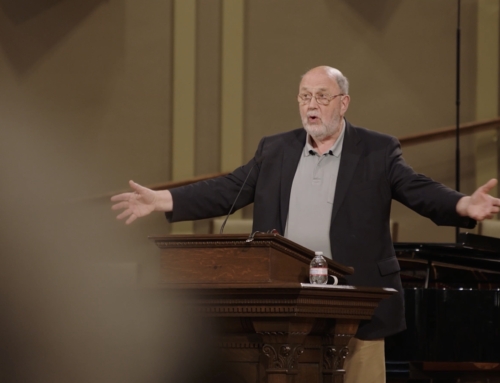This article was inspired by Professor Wright’s recent course, The Servant King. The course, which covers Isaiah 40-55, is on sale until midnight PST November 26th.
‘Everyone is hiding a secret sorrow somewhere’.
This maxim from Professor N.T. Wright’s latest course, The Servant King, opened my eyes to consider the human tendency to put on a happy face and bury our hurts deep within. Underneath our placid and pleasant expressions there is often unexpressed grief, painful betrayals, bitter resentments, or disappointments and discouragement that others know nothing about.
The psalmist cried out to God:
Why are you cast down, O my soul,
and why are you disquieted within me?
Hope in God; for I shall again praise him, my helpPsalm 42:5 NRSV
The Septuagint, the Greek translation of the Old Testament, retains the original Hebrew, paneh, which means face (countenance), or the presence or proximity of someone understood with the implication of being before them or in front of them.
Wherefore art thou very sad, O my soul?
and wherefore dost thou trouble me?
Hope in God; for I will give thanks to him;
he is the salvation of my countenance.
When we need encouragement for our secret sorrows, or comfort as we encounter difficult issues or relationships, we need more than just strategies for ‘saving face’ or pithy counsel to turn our frown upside down. The church holds out the Word and proclaims God’s enfacing Spirit-filled presence who shines upon our dark places of shrouded sadness. And, it is precisely God’s forward-facing Servant King that infuses people with courage to meet the hidden despairs of the heart—he is the hope, healing, and deliverance of our face.
Jesus ‘Set His Face’
A few years ago, when I was facing a particularly tough and anxiety-inducing issue, my Pastor (and my boss), David Seemuth, reminded me of a passage from Luke 9:51 that makes this abstract idea slightly more concrete:
And it came to pass, when the time was come that he should be received up, he steadfastly set his face to go to Jerusalem.
In determining to set out towards Jerusalem, Jesus resolutely faced the ‘other’, the enemy, in order that estranged humans might be reconciled with their Creator God. With arms opened wide he redefined the possibilities for divine-human connection, but also of painful rejection, which is always part and parcel of vulnerability in relationship. This self-giving and other-focused love literally enfaced the world with God’s redeeming and healing love.
Earlier in Luke 9:28-36, Jesus’ face was transfigured and the disciples witnessed something totally beyond words. It is easy to see why Peter wanted to remain. Yet, Jesus rejected the idea of tabernacling on high, above the chaos and confusion. Instead, he and his disciples returned from the mountaintop and re-entered the messy realm of humankind. Indeed, Jesus resolutely continued his mission to face the ultimate human trial—death—knowing that victory over the power of sin would emerge by his humility and obedience and through his suffering.
Power the Other Way
Prof. Wright reinforces that God’s Servant King, Jesus, Messiah, headed straight for Jerusalem with a different kind of power in mind. Indeed, he did not triumphantly enter his kingdom and claim the throne by way of oppression, domination, threats, or bullying. Instead, Jesus insisted that he and his followers were going to do ‘power the other way’. It is precisely this type of genuine human power that would transfigure the possibilities of what it means to be truly human in the world.
When we are ashamed, we often feel like hiding because we cannot bear to face others. Human psychology informs us that shame often manifests itself in the eyes and face. Those who are shame-filled avert the gaze of other people, with their eyes cast down to match their inner spirit. When God took humanity upon himself in the person of Jesus Christ, he squarely faced our brokenness by standing for us and with us.
Jesus reflects the genuine human being that has no need for hiding. He looked the devastation of the human condition ‘in the eyes’ by headed straight for it, in order to fully embrace you, and to embrace me. His is a saving face that engages human destructiveness and brings healing that transforms human patterns of relationships.
Responding to Sorrow Like Jesus
Have you ever been reluctant to face something painful or difficult? Or, have you ever wanted to face someone that seemingly did not want to have anything to do with you? Jesus similarly faced challenging and sorrowful situations. He was rejected and despised; even his own did not receive him. Yet, he did not respond by retaliating and destroying, but rather, with saving grace and deliverance of our countenance—this is power done the other way.
May we be encouraged to expose our hidden sorrows to God and others. May we receive what Jesus faced for us and with us, and extend his self-giving and other-focused love to people who all have secret sorrows somewhere.
Jennifer Loop
Latest posts by Jennifer Loop (see all)
- Why You Need Lent: Two Perspectives - February 22, 2023
- How (Not) To Understand a Parable - October 20, 2022
- What People are Saying About ‘Ethnicity, Justice and the People of God’ - February 10, 2022







